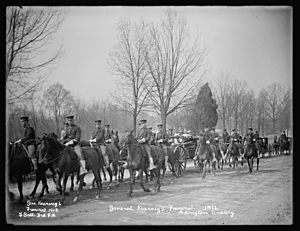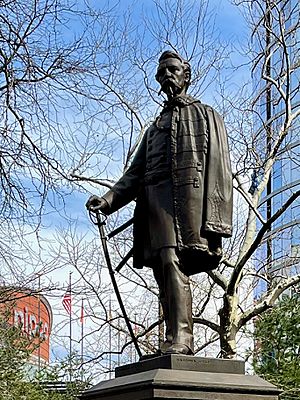Philip Kearny facts for kids
Quick facts for kids
Philip Kearny Jr.
|
|
|---|---|
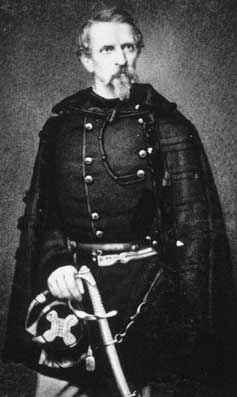
Philip Kearny
|
|
| Nickname(s) | "Kearny the Magnificent" |
| Born | June 1, 1815 New York City, New York, U.S. |
| Died | September 1, 1862 (aged 47) Chantilly, Virginia, U.S. |
| Place of burial | |
| Allegiance | |
| Service/ |
|
| Years of service | 1837–1851; 1861–1862 (US) 1859–1861 (France) |
| Rank | |
| Commands held | First New Jersey Brigade |
| Battles/wars | |
| Signature | |
Philip Kearny Jr. (born June 1, 1815 – died September 1, 1862) was a brave officer in the United States Army. He is famous for his leadership during the Mexican–American War and the American Civil War. He sadly died in battle during the Battle of Chantilly in 1862.
Contents
Early Life and Military Start
Philip Kearny Jr. was born in New York City into a very rich Irish American family. His parents were Philip Kearny Sr. and Susan Watts. His grandfather, John Watts, was one of New York's wealthiest people. He owned many ships, factories, banks, and other businesses.
Philip's father was a successful financier who helped start the New York Stock Exchange. From a young age, Philip wanted to be a soldier. His parents passed away when he was young, so his grandfather raised him.
His grandfather wanted him to become a lawyer, even though Philip dreamed of a military career. Philip went to Columbia College and earned a law degree in 1833.
In 1836, his grandfather died and left Philip a huge fortune, worth over $1 million. This allowed him to follow his dream of joining the army.
Joining the Cavalry
The next year, Philip became a second lieutenant (a young officer) in the 1st U.S. Dragoons. This was a cavalry unit led by his uncle, Colonel Stephen W. Kearny. Jefferson Davis, who would later become president of the Confederacy, was also a chief assistant in this unit. They were stationed on the western frontier.
In 1839, Kearny was sent to France to learn about cavalry tactics (how cavalry soldiers fight). He attended a famous cavalry school in Saumur. He even fought in battles with the Chasseurs d'Afrique (a French cavalry unit) in Algeria.
Kearny was incredibly brave in battle. He would ride with a sword in one hand, a pistol in the other, and the horse's reins in his teeth! His French comrades called him Kearny le Magnifique ("Kearny the Magnificent") because of his fearless spirit. He returned to the U.S. in 1840 and wrote a manual for the Army based on what he learned.
He then served as an aide-de-camp (a personal assistant) to General Alexander Macomb and later to General Winfield Scott. He also spent time on the frontier, joining his uncle's unit on a trip to the Oregon Trail in 1845.
Service in the Mexican War
Kearny was eager for more action. He briefly left the army in 1846 but rejoined a month later when the Mexican–American War began. He was tasked with forming a cavalry troop, Company F, for the 1st U.S. Dragoons.
He spent his own money to recruit 120 men and buy matching dapple gray horses. His unit first served at the Rio Grande but soon became the personal bodyguards for General Scott, the main commander in Mexico. Kearny was promoted to captain in December 1846.
A Hero's Courage
Kearny and his men fought bravely in the Battles of Contreras and Churubusco. In the Battle of Churubusco, Kearny led a daring cavalry charge. During this fight, he was hit by a cannonball fragment in his left arm, which later had to be removed.
Even with this severe injury, Kearny quickly returned to duty. When the U.S. Army entered Mexico City the next month, he had the special honor of being the first soldier through the city gates. General Winfield Scott called him "a perfect soldier" and "the bravest man I ever knew."
After the war, Kearny was given a special sword by the Union Club of New York for his service. He was also promoted to major.
Life After the Mexican War
In 1851, Kearny fought against the Rogue River Indians in Oregon. Later that year, he resigned from the army because he was unhappy with how slowly officers were promoted.
He then traveled the world, visiting China, Ceylon, and France. In Paris, he met and fell in love with Agnes Maxwell. He couldn't marry her right away because his first wife would not agree to a divorce.
In 1854, Kearny was hurt when his horse fell through a broken bridge. Agnes moved in to care for him. By 1855, they moved to Kearny's new home, Bellegrove, in what is now Kearny, New Jersey. In 1858, his first wife finally granted a divorce, and Kearny and Agnes moved to Paris, where they were married.
Fighting for France Again
In 1859, Kearny rejoined the Chasseurs d'Afrique in France. They were fighting against Austrian forces in Italy. He later joined Napoleon III's Imperial Guard at the Battle of Solferino.
During this battle, Kearny charged with the cavalry, breaking through the Austrian lines and capturing a key position. For his bravery, he received the French Légion d'honneur, becoming the first U.S. citizen to receive this high award.
The American Civil War
When the American Civil War began in 1861, Kearny returned to the United States. He was appointed a brigadier general and given command of the First New Jersey Brigade. He trained them well.
The army had been hesitant to let him rejoin because of his missing arm. However, after the Union defeat at the First Battle of Bull Run, they realized they needed experienced officers like him. His brigade performed exceptionally well, especially at the Battle of Glendale.
On April 30, 1862, he took command of the 3rd Division of the III Corps. He led his division in the Battle of Williamsburg and the Battle of Fair Oaks. At Williamsburg, he famously shouted, "I'm a one-armed Jersey son-of-a-gun, follow me!" He led the charge with his sword in hand and the reins in his teeth. He also told his troops, "Don't worry, men, they'll all be firing at me!"
His actions during the Peninsula Campaign earned him great respect. He often ignored orders from his commander, Maj. Gen. George B. McClellan, especially orders to retreat.
Unit Insignia Patches
Kearny is known for creating the first unit insignia patches used in the U.S. Army. In the summer of 1862, he ordered his officers to wear a red cloth patch on their caps to identify themselves as part of his unit.
His soldiers, who liked him very much, quickly started wearing them too. Other units saw this idea and created their own patches. These patches eventually led to the modern shoulder patches worn by soldiers today. Kearny was promoted to major general on July 4, 1862.
Death in Battle
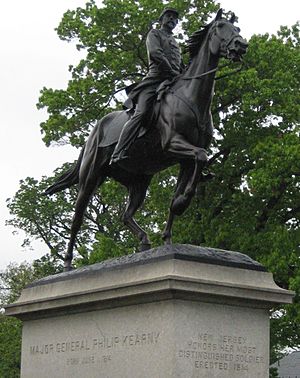
In late August 1862, General Kearny led his division at the difficult Second Battle of Bull Run. The Union Army was badly defeated by General Robert E. Lee's Confederate Army. The Union army retreated towards Washington.
On September 1, 1862, they fought the pursuing Confederate troops at the Battle of Chantilly. During a violent storm, Kearny rode out to check a gap in the Union line. When warned about danger, he said, "The Rebel bullet that can kill me has not yet been molded."
He encountered Confederate soldiers and refused to surrender. As he tried to escape on horseback, he was shot and killed instantly. Confederate Maj. Gen. A.P. Hill found Kearny's body and said, "You've killed Phil Kearny! he deserved a better fate than to die in the mud."
Confederate soldiers took Kearny's belongings, but when General Lee realized who had been killed, he ordered everything returned. Lee sent Kearny's body back to the Union forces with a note of sympathy.
At the time of his death, there were rumors that President Abraham Lincoln was thinking of replacing General McClellan with "Kearny the Magnificent."
Kearny was first buried in New York. In 1912, his remains were moved to Arlington National Cemetery. A statue of him on horseback, created by Edward Clark Potter, marks his grave. This statue was dedicated by President Woodrow Wilson in 1914.
Legacy and Honors
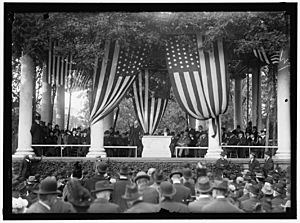
- The town of Kearny, New Jersey, is named in his honor. A statue of him stands outside the Kearny post office.
- Fort Kearny, part of Washington, D.C.'s defenses, was named for him.
- Fort Phil Kearny in Wyoming was also named after him.
- A statue of Kearny represents New Jersey in the National Statuary Hall Collection in the U.S. Capitol.
- Kearny Memorial Park in Muskegon, Michigan, features a statue and fountain in his honor.
- Another statue of Kearny stands in Military Park, Newark, New Jersey.
- A small monument at Ox Hill Battlefield Park remembers Kearny's death.
- A carving on the First New Jersey Brigade monument at Gettysburg honors Kearny's leadership.
- The General Philip Kearny Public School in Philadelphia was named for him in 1921.
- During World War II, a Liberty Ship was named the SS Philip Kearny.
- Kearny County, Kansas, is named for him.
- In 2017, Kearny was added to the New Jersey Hall of Fame.
See also
- List of American Civil War generals (Union)
- Kearny Cross




